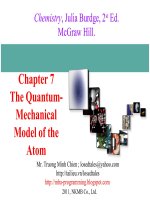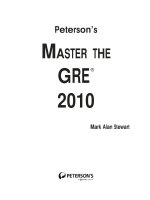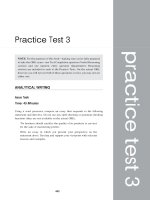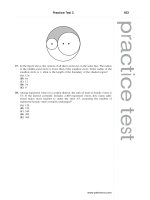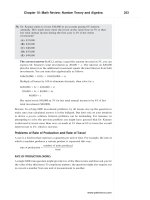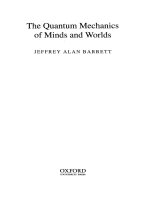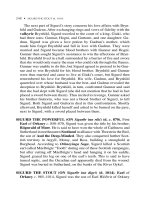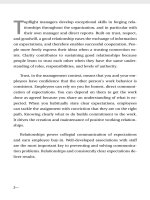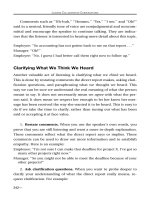The Quantum Mechanics Solver 28 docx
Bạn đang xem bản rút gọn của tài liệu. Xem và tải ngay bản đầy đủ của tài liệu tại đây (275.48 KB, 15 trang )
27
Bloch Oscillations
The possibility to study accurately the quantum motion of atoms in standing
light fields has been used recently in order to test several predictions relating
to wave propagation in a periodic potential. We present in this chapter some
of these observations related to the phenomenon of Bloch oscillations.
27.1 Unitary Transformation on a Quantum System
Consider a system in the state |ψ(t) which evolves under the effect of a
Hamiltonian
ˆ
H(t). Consider a unitary operator
ˆ
D(t). Show that the evolution
of the transformed vector
|
˜
ψ(t) =
ˆ
D(t)|ψ(t)
is given by a Schr¨odinger equation with Hamiltonian
˜
ˆ
H(t)=
ˆ
D(t)
ˆ
H(t)
ˆ
D
†
(t)+i¯h
d
ˆ
D(t)
dt
ˆ
D
†
(t) .
27.2 Band Structure in a Periodic Potential
The mechanical action of a standing light wave onto an atom can be described
by a potential (see e.g. Chap. 26). If the detuning between the light frequency
and the atom resonance frequency ω
A
is large compared to the electric dipole
coupling of the atom with the wave, this potential is proportional to the light
intensity. Consequently, the one-dimensional motion of an atom of mass m
moving in a standing laser wave can be written
ˆ
H =
ˆ
P
2
2m
+ U
0
sin
2
(k
0
ˆ
X) ,
278 27 Bloch Oscillations
where
ˆ
X and
ˆ
P are the atomic position and momentum operators and where
we neglect any spontaneous emission process. We shall assume that k
0
ω
A
/c
and we introduce the “recoil energy” E
R
=¯h
2
k
2
0
/(2m).
27.2.1. (a) Given the periodicity of the Hamiltonian
ˆ
H, recall briefly why
the eigenstates of this Hamiltonian can be cast in the form (Bloch theo-
rem):
|ψ =e
iq
ˆ
X
|u
q
,
where the real number q (Bloch index) is in the interval (−k
0
,k
0
)and
where |u
q
is periodic in space with period λ
0
/2.
(b) Write the eigenvalue equation to be satisfied by |u
q
. Discuss the corre-
sponding spectrum (i) for a given value of q, (ii) when q varies between
−k
0
and k
0
.
In the following, the eigenstates of
ˆ
H are denoted |n, q, with energies E
n
(q).
They are normalized on a spatial period of extension λ
0
/2=π/k
0
.
27.2.2. Give the energy levels in terms of the indices n and q in the case
U
0
=0.
27.2.3. Treat the effect of the potential U
0
in first order perturbation theory,
for the lowest band n = 0 (one should separate the cases q = ±k
0
and q
“far from” ±k
0
). Give the width of the gap which appears between the bands
n =0andn = 1 owing to the presence of the perturbation.
27.2.4. Under what condition on U
0
is this perturbative approach reliable?
27.2.5. How do the widths of the other gaps vary with U
0
in this perturbative
limit?
27.3 The Phenomenon of Bloch Oscillations
We suppose now that we prepare in the potential U
0
sin
2
(k
0
x)awavepacket
in the n = 0 band with a sharp distribution in q, and that we apply to the
atom a constant extra force F = ma.
We recall the adiabatic theorem: suppose that a system is prepared at time
0 in the eigenstate |φ
(0)
n
of the Hamiltonian
ˆ
H(0). If the Hamiltonian
ˆ
H(t)
evolves slowly with time, the system will remain with a large probability in
the eigenstate |φ
(t)
n
. The validity condition for this theorem is ¯hφ
(t)
m
|
˙
φ
(t)
n
|E
m
(t) −E
n
(t)| for any m = n. We use the notation |
˙
φ
(t)
n
=
d
dt
|φ
(t)
n
.
27.3.1. Preparation of the Initial State. Initially U
0
=0,a =0and
the atomic momentum distribution has a zero average and a dispersion small
27.3 The Phenomenon of Bloch Oscillations 279
compared to ¯hk. We will approximate this state by the eigenstate of momen-
tum |p =0. One “slowly” switches on the potential U
0
(t)sin
2
(k
0
x), with
U
0
(t) ≤ E
R
.
(a) Using the symmetries of the problem, show that the Bloch index q is a
constant of the motion.
(b) Write the expression of the eigenstate of H(t) of indices n =0,q =0to
first order in U
0
.
(c) Evaluate the validity of the adiabatic approximation in terms of
˙
U
0
,E
R
, ¯h.
(d) One switches on linearly the potential U
0
until it reaches the value E
R
.
What is the condition on the time τ of the operation in order for the
process to remain adiabatic? Calculate the minimal value of τ for cesium
atoms (m =2.2 ×10
−25
kg, λ
0
=0.85 µm.)
27.3.2. Devising a Constant Force. Once U
0
(t) has reached the maximal
value U
0
(time t = 0), one achieves a sweep of the phases φ
+
(t)andφ
−
(t)of
the two traveling waves forming the standing wave. The potential seen by the
atom is then U
0
sin
2
(k
0
x −(φ
+
(t) −φ
−
(t))/2) and one chooses
φ
+
(t) −φ
−
(t)=k
0
at
2
.
(a) Show that there exists a reference frame where the wave is stationnary,
and give its acceleration.
(b) In order to study the quantum motion of the atoms in the accelerated
reference frame, we consider the unitary transformation generated by
ˆ
D(t)=exp(iat
2
ˆ
P/2¯h)exp(−imat
ˆ
X/¯h)exp(ima
2
t
3
/(3¯h)) .
How do the position and momentum operators
ˆ
X and
ˆ
P transform? Write
the resulting form of the Hamiltonian in this unitary transformation
˜
ˆ
H =
ˆ
P
2
2m
+ U
0
sin
2
(k
0
ˆ
X)+ma
ˆ
X.
27.3.3. Bloch Oscillations
We consider the evolution of the initial state n =0,q = 0 under the effect of
the Hamiltonian
˜
ˆ
H.
(a) Check that the state vector remains of the Bloch form, i.e.
|ψ(t) =e
iq(t)
ˆ
X
|u(t) ,
where |u(t) is periodic in space and q(t)=−mat/¯h.
(b) What does the adiabatic approximation correspond to for the evolution
of |u(t)? We shall assume this approximation to be valid in the following.
280 27 Bloch Oscillations
(c) Show that, up to a phase factor, |ψ(t) is a periodic function of time, and
give the corresponding value of the period.
(d) The velocity distribution of the atoms as a function of time is given
in Fig. 27.1. The time interval between two curves is 1 ms and a =
−0.85 ms
−2
. Comment on this figure, which has been obtained with ce-
sium atoms.
Fig. 27.1. Atomic momentum distribution of the atoms (measured in the acceler-
ated reference frame) for U
0
=1.4 E
R
.Thelower curve corresponds to the end of
the preparation phase (t = 0) and the successive curves, from bottom to top,are
separated by time intervals of one millisecond. For clarity, we put a different vertical
offset for each curve
27.4 Solutions 281
27.4 Solutions
Section 27.1: Unitary Transformation on a Quantum System
The time derivative of |
˜
ψ gives
i¯h|
˙
˜
ψ =i¯h
˙
ˆ
D|ψ +
ˆ
D|
˙
ψ
=i¯h
˙
ˆ
D
ˆ
D
†
+
ˆ
D
ˆ
H
ˆ
D
†
ˆ
D|ψ ,
hence the results of the lemma.
Section 27.2: Band Structure in a Periodic Potential
27.2.1. Bloch theorem
(a) The atom moves in a spatially periodic potential, with period λ
0
/2=
π/k
0
. Therefore the Hamiltonian commutes with the translation operator
ˆ
T (λ
0
/2) = exp(iλ
0
ˆ
P/(2¯h)) and one can look for a common basis set of
these two operators. Eigenvalues of
ˆ
T (λ
0
/2) have a modulus equal to 1, since
ˆ
T (λ
0
/2) is unitary. They can be written e
iqλ
0
/2
where q is in the interval
(−k
0
,k
0
). A corresponding eigenvector of
ˆ
H and
ˆ
T (λ
0
/2) is then such that
ˆ
T (λ
0
/2)|ψ =e
iqλ
0
/2
|ψ
or in other words
ψ(x + λ
0
/2) = e
iqλ
0
/2
ψ(x) .
This amounts to saying that the function u
q
(x)=e
−iqx
ψ(x)isperiodicin
space with period λ
0
/2, hence the result.
(b) The equation satisfied by u
q
is:
−
¯h
2
2m
d
dx
+iq
2
u
q
+ U
0
sin
2
(kx) u
q
= Eu
q
.
For a fixed value of q, we look for periodic solutions of this equation. The
boundary conditions u
q
(λ
0
/2) = u
q
(0) and u
q
(λ
0
/2) = u
q
(0) lead, for each
q, to a discrete set of allowed values for E, which we denote E
n
(q). The
corresponding eigenvector of
ˆ
H and
ˆ
T (λ
0
/2) is denoted |ψ = |n, q.Now
when q varies in the interval (−k
0
,k
0
), the energy E
n
(q) varies continuously
in an interval (E
min
n
,E
max
n
). The precise values of E
min
n
and E
max
n
depend on
the value of U
0
. The spectrum E
n
(q) is then constituted by a series of allowed
energy bands, separated by gaps corresponding to forbidden values of energy.
The interval (−k
0
,k
0
) is called the first Brillouin zone.
27.2.2. For U
0
= 0, the spectrum of
ˆ
H is simply ¯h
2
k
2
/(2m) corresponding
to the eigenstates e
ikx
(free particle). Each k can be written: k = q +2nk
0
where n is an integer, and the spectrum E
n
(q) then consists of folded portions
of parabola (see Fig. 27.2a). There are no forbidden gaps in this case, and the
various energy bands touch each other (E
min
n+1
= E
max
n
).
282 27 Bloch Oscillations
Fig. 27.2. Structure of the energy levels E
n
(q)(a)forU
0
=0and(b) U
0
= E
R
27.2.3. When q is far enough from ±k
0
, the spectrum of
ˆ
H has no degeneracy,
and the shift of the energy level of the lowest band n = 0 can be obtained
using simply:
∆E
0
(q)=0,q|U
0
sin
2
(k
0
ˆ
X)|0,q
=
k
0
π
π/k
0
0
e
−iqx
U
0
sin
2
(k
0
x)e
iqx
dx =
U
0
2
.
When q is equal to ±k
0
, the bands n =0andn = 1 coincide and one should
diagonalize the restriction of U (x) to this two-dimensional subspace. One gets
0,k
0
|U
0
sin
2
(k
0
ˆ
X)|0,k
0
= 1,k
0
|U
0
sin
2
(k
0
ˆ
X)|1,k
0
=
U
0
2
,
0,k
0
|U
0
sin
2
(k
0
ˆ
X)|1,k
0
= 1,k
0
|U
0
sin
2
(k
0
ˆ
X)|0,k
0
= −
U
0
4
.
The diagonalization of the matrix
U
0
4
2 −1
−12
gives the two eigenvalues 3U
0
/4andU
0
/4, which means that the two bands
n =0andn = 1 do not touch each other anymore, but that they are separated
by a gap U
0
/2 (see Fig. 27.2b for U
0
= E
R
).
27.2.4. This perturbative approach is valid if one can neglect the coupling
to all other bands. Since the characteristic energy splitting between the band
n = 1 and the band n = 2 is 4 E
R
, the validity criterion is
U
0
4 E
R
.
27.2.5. The other gaps open either at k =0ork = ±k
0
.Theyresultfrom
the coupling of e
ink
0
x
and e
−ink
0
x
under the influence of U
0
sin
2
(k
0
x). This
coupling gives a non-zero result when taken at order n. Therefore the other
gaps scale as U
n
0
and they are much smaller that the lowest one.
27.4 Solutions 283
Section 27.3: The phenomenon of Bloch Oscillations
27.3.1. Preparation of the Initial State
(a) Suppose that the initial state has a well defined Bloch index q,which
means that
ˆ
T (λ
0
/2)|ψ(0) =e
iqλ
0
/2
|ψ(0) .
At any time t, the Hamiltonian
ˆ
H(t) is spatially periodic and commute with
the translation operator
ˆ
T (λ
0
/2). Therefore the evolution operator
ˆ
U(t) also
commutes with
ˆ
T (λ
0
/2). Consequently:
ˆ
T (λ
0
/2)|ψ(t) =
ˆ
T (λ
0
/2)
ˆ
U(t)|ψ(0) =
ˆ
U(t)
ˆ
T (λ
0
/2)|ψ(0) ,
=e
iqλ
0
/2
|ψ(t) ,
which means that q is a constant of motion.
(b) At zeroth order in U
0
, the eigenstates of H corresponding to the Bloch
index q = 0 are the plane waves |k =0 (energy 0), |k = ±2k
0
(energy
4E
R
), At first order in U
0
, in order to determine |n =0,q =0,wehave
to take into account the coupling of |k =0 with |k = ±2k
0
, which gives
|n =0,q=0 = |k =0 +
=±
k =2k
0
|U
0
sin
2
k
0
x|k =0
4E
R
|k =2k
0
.
The calculation of the matrix elements is straightforward and it leads to
x|n =0,q=0∝1+
U
0
(t)
8E
R
cos(2k
0
x) .
(c) The system will adiabatically follow the level |n =0,q =0 as the
potential U
0
is raised, provided for any n
¯hn
,q =0|
d|n =0,q=0
dt
E
n
(0) −E
0
(0) .
Using the value found above for |n =0,q =0 and taking n
= ±1, we derive
the validity criterion for the adiabatic approximation in this particular case:
¯h
˙
U
0
64 E
2
R
.
(d) For a linear variation of U
0
such that U
0
= E
R
t/τ, this validity condition
is
τ ¯h/(64 E
R
) ,
which corresponds to τ 10 µs for cesium atoms.
284 27 Bloch Oscillations
27.3.2. Devising a Constant Force
(a) Consider a point with coordinate x in the lab frame. In the frame with
acceleration a and zero initial velocity, the coordinate of this point is x
=
x −at
2
/2. In this frame, the laser intensity varies as sin
2
(kx
), corresponding
to a “true” standing wave.
(b) Using the standard relations [
ˆ
X,f(
ˆ
P )] = i¯hf
(
ˆ
P )and[
ˆ
P,g(
ˆ
X)] =
−i¯hg
(
ˆ
X), one gets
ˆ
D
ˆ
X
ˆ
D
†
=
ˆ
X +
at
2
2
ˆ
D
ˆ
P
ˆ
D
†
=
ˆ
P + mat .
The transformed Hamiltonian
ˆ
D
ˆ
H
ˆ
D
†
is
ˆ
D
ˆ
H
ˆ
D
†
=
1
2m
ˆ
P + mat
2
+ U
0
sin
2
(k
0
ˆ
X) ,
and the extra term appearing in
˜
ˆ
H can be written
i¯h
d
ˆ
D
dt
ˆ
D
†
= −at
ˆ
P + ma
ˆ
X −
ma
2
t
2
2
.
Summing the two contributions, we obtain
˜
ˆ
H =
ˆ
P
2
2m
+ U
0
sin
2
(k
0
ˆ
X)+ma
ˆ
X.
This Hamiltonian describes the motion of a particle of mass m in a periodic
potential, superimposed with a constant force – ma.
27.3.3. Bloch Oscillations
(a) The evolution of the state vector is i¯h|
˙
ψ =
˜
ˆ
H|ψ. We now put |ψ(t) =
exp(−imat
ˆ
X/¯h)|u(t) and we look for the evolution of |u(t). We obtain after
a straightforward calculation
i¯h
∂u(x, t)
∂t
= −
¯h
2
2m
∂
∂x
−
imat
¯h
2
u(x, t)+U
0
sin
2
(k
0
x) u(x, t) .
Using the structure of this equation, and using the initial spatial periodicity
of u(x, 0), one deduces that u(x, t) is also spatially periodic with the same
period λ
0
/2.
(b) The adiabatic hypothesis for |u(t) amounts to assume that this vector,
which is equal to |u
n=0,q=0
at t = 0, remains equal to |u
0,q(t)
at any time.
The atom stays in the band n =0.
(c) Consider the duration T
B
=2¯hk
0
/(ma) during which q(t) is changed into
q(t) −2k
0
. Since 2k
0
is the width of the Brillouin zone, we have |u
n,q−2k
0
≡
|u
n,q
. Consequently, when the adiabatic approximation is valid, the state
|ψ(t + T
B
) coincides (within a phase factor) with the state |ψ(t). Since this
phase factor does not enter in the calculation of physical quantities such as
27.5 Comments 285
position or momentum distributions, we expect that the evolution of these
quantities with time will be periodic with the period T
B
.
(d) We first note that the initial distribution is such that the average mo-
mentum is zero, and that the momentum dispersion is small compared with
¯hk
0
, as assumed in this problem. Concerning the time evolution, we see in-
deed that the atomic momentum distribution is periodic in time, with a period
T
B
8 ms, which coincides with the predicted value 2¯hk
0
/(ma). Finally we
note that the average momentum increases quasi-linearly with time during the
first 4 ms, from 0 to ¯hk
0
. At this time corresponding to T
B
/2, a “reflexion”
occurs and the momentum is changed into −¯hk
0
. During the second half of
the Bloch period (from 4 ms to 8 ms) the momentum again increases linearly
with time from −¯hk
0
to 0. At the time T
B
/2, the particle is at the edge of the
Brillouin zone (q = ±k
0
). This is the place where the adiabatic approxima-
tion is the most fragile since the band n = 1 is then very close to the band
n = 0 (gap U
0
). One can check that the validity criterion for the adiabatic
approximation at this place is maE
R
k
0
U
2
0
, which is well fullfilled in the
experiment. The reflection occurring at t = T
B
/2 can be viewed as a Bragg
reflection of the atom with momentum ¯hk
0
on the periodic grating U
0
sin
2
(kx).
27.5 Comments
This paradoxical situation, where a constant force ma leads to an oscillation
of the particle instead of a constant acceleration, is called the Bloch oscillation
phenomenon. It shows that an ideal crystal cannot be a good conductor: when
one applies a potential difference at the edge of the crystal, the electrons of
the conduction band feel a constant force in addition to the periodic potential
created by the crystal and they should oscillate instead of being accelerated
towards the positive edge of the crystal. The conduction phenomenon results
from the defects present in real metals.
The experimental data have been extracted from M. Ben Dahan, E. Peik,
J. Reichel, Y. Castin, and C. Salomon, Phys. Rev. Lett. 76, 4508 (1996) and
from E. Peik, M. Ben Dahan, I. Bouchoule, Y. Castin, and C. Salomon, Phys.
Rev. A 55, 2989 (1997). A review of atom optics experiments performed with
standing light waves is given in M. Raizen, C. Salomon, and Q. Niu, Physics
Today, July 1997, p. 30.
Author Index
Abasov, A.I. et al., 27
Abdurashitov, J.N. et al., 27
Ahmad, Q. R. et al., 27
Anderson, M.H., 202
Andrews, M.R., 202
Anselmann, P. et al., 27
Ashkin, A., 276
Aspect, A., 101, 108
Barnett, S.M., 167
Basdevant, J L., 192
Bastard, G., VII
Bell, J.S., 99, 108
Ben Dahan, M., 285
Berkhout, J., 265
Berko, S., 80
Berlinsky, A.J., 265
Biraben, F., 82
Bjorkholm, J.E., 276
Bouchoule, I., 285
Bradley, C., 202
Brune, M., 119, 145
Cable, A., 276
Castin, Y., VII, 285
Chazalviel, J N., VII
Chazalviel, J.N., 239
Chu, S., 80, 276
Clairon, A., 36
Cohen-Tannoudji, C., 276
Collela, A.R., 45
Corben, H.C., 80
Cornell, E.A., 202
Courty, J M., VII
Crane, H.R., 66
Dalibard, J., 108
Davis R., 27
DeBenedetti, S., 80
Dehmelt, H., 276
Delande, D., VII, 82
Dorner, B., 213
Doyle, J.M., 265
Dress, W.D., 53
Dreyer, J., 119, 145
Durfee, D.S., 202
Einstein, A., 99, 100, 108
Ensher, J.R., 202
Equer, B., VII
Fischer, M., 36
Fukuda Y., 27
Gabrielse, G., 182
GALLEX Collaboration, 27
Gay, J C., 82
Gillet, V., VII
Grangier, P., VII, 108, 153, 167
Greenberger, D., 45
Greene, G.L., 53
Grynberg, G., VII
H¨ansch, T.W., 276
Hagley, E., 119, 145
Hameau, S., 229
Haroche, S., 119, 145
Hollberg, L., 276
288 Author Index
Hulet, R.G., 202
Jacquet, F., VII
Jolicoeur, T., VII
K2K collaboration, 27
KamLAND collaboration, 27
Ketterle, W., 202
Kinoshita, T., 80
Koshiba M., 27
Kurn, D.M., 202
Maali, A., 119, 145
Maitre, X., 119
Maleki, L., 36
Mampe, W., 53
Marion, H., 36
Martin, A., 192
Matthews, M.R., 202
Metcalf, H., 276
Mewes, M O., 202
Miller, P.D., 53
Mills, A.P., 80
Neuman, J. von, 147
Niu, Q., 285
Overhauser, A.W., 37, 45
Peik, E., 285
Peil, S., 182
Pendlebury, J.M., 53
Pendleton, H.N., 80
Penent, F., 82
Perrin, P., 53
Phillips, W.D., 276
Platt, J.R., 235
Podolsky, B., 99, 108
Poizat, J.P., 153, 167
Prestage, J.D., 36
Prodan, J.V., 276
Raimond, J M., 119, 145
Raizen, M., 285
Ramsey, N.F., 47, 53, 156
Reichel, J., 285
Rich, J., VII
Richard, J M., 192
Roger, G., 108
Rosen, N., 99, 108
Roug´e, A., VII
Sackett, C.A., 202
SAGE Collaboration, 27
Salomon, C., 36, 285
Santarelli, G., 36
Schawlow. A., 276
Schmidt-Kaler, F., 145
Schr¨odinger, 109
Smith, J.H., 166
Smith, K.F., 53, 167
Smy, M.B., 27
Stoler, D., 119
Tjoelker, R.L., 36
van Druten, N.J., 202
von Neuman, J., 147
Weinheimer et al., 72
Werner, S.A., 45
Wieman, C.E., 202
Wilkinson, D.T., 66
Wineland, D., 276
Wu, Tai Tsun, 192
Wunderlich, C., 119
Yurke, B., 119
Zimmerman, D.S., 265
Subject Index
absorption, 239, 272
addition of angular momenta, 7, 29
adiabatic theorem, 278
alakali atom, 29
angular momenta
addition, 7, 29
angular momentum, 6
annihilation, 75, 132
annihilation and creation operators, 109
antineutrino, 69
antinode, 234
antiparticle, 17
antiquark, 187
atmospheric neutrinos, 20
atomic clocks, 29
atomic fountain, 31
β decay, 17, 69
Band structure, 277
baryon, 187
Bell’s inequality, 99, 102, 107
Bell’s theorem, 102
Bethe-Bloch formula, 94
Bloch index, 278
Bloch oscillations, 277, 278, 284
Bloch theorem, 278
blue shift, 233
Bohr radius, 69, 82, 240
Born approximation, 12
Bose–Einstein condensate, 193, 195
boson, 10
Bragg angle, 37
Bragg reflection, 285
Brillouin zone, 281, 284
broad line condition, 273
cat paradox, 109
cesium, 29, 32
cesium atom, 283
cesium atoms, 279
•
CH
3
(methyl), 239
CH
3
−
•
COH−COO
−
, 240
chain of coupled spins, 203
chain of molecules, 204
coherence properties, 193
collision, 12
condensate, 193
conductor, 285
cooling time, 273, 274
correlated pairs of spins, 122
correlation coefficient, 100
Coulomb correlations, 229
Coulomb potential, 8
creation, 132
cross section, 12
crossed Kerr effect, 153
cryptography, 121
CSCO, 3
Cs Fe Br
3
, 204
damped oscillation, 135
damping, 113
damping time, 137, 144
decay, 75
degeneracy, 206
density operator, 3, 247, 251, 267
diffraction peak, 60
290 Subject Index
Dirac distribution, 5
dispersion relation, 257
Doppler cooling, 267, 269
Doppler shift, 52
drift of fundamental constants, 32
Ehrenfest theorem, 4, 59, 61, 67, 139
Einstein-Podolsky-Rosen paradox, 99
electric dipole, 267
electric dipole coupling, 277
electric dipole moment, 166
electromagnetic wave, 31
electron magnetic moment anomaly, 65
electron spin, 100
electron spin resonance, 237
energy bands, 281
energy loss, 87
entangled states, 3, 99
entanglement, 3
eraser, 155
excitons, 206
factorized spin, 100
Fermi
golden rule, 11
fermion, 10
field quantization, 131
fine structure constant, 32
flavor, 20
form factor, 13
Fourier transform, 4
free radicals, 237
G.P.S., 29, 32
gravitational field, 37
gravitational potential, 43
gyromagnetic ratios, 237
Hamiltonian, 2
harmonic oscillator, 7, 109, 197
harmonic potential, 193
3
He
+
,69
heavy ion therapy, 94
Heisenberg inequalities, 60
hidden variables, 99, 101
Hilbert space, 1
holes, 211
hydrocarbon ions, 231
hydrogen, 249, 255
hydrogen atom, 73, 81
hyperfine interaction, 29, 237, 238
hyperfine splitting, 73
hyperfine structure, 237
hyperfine transition, 74
identical particles, 10
interaction time, 88, 91
interference, 155, 159
ion beams, 94
ion therapy, 94
ionization energy, 69
ions in matter, 87
isotope, 69
Jacobi variables, 187, 190
joint probability, 165
KamLAND, 19
ket, 1
Laboratoire Kastler Brossel, 145
Laguerre polynomial, 9
Larmor frequency, 67
Larmor precession, 47
laser cooling, 267
LEP, 18
lepton, 17
lifetime, 12
liquid helium, 255, 258
lithium atoms, 197
local hidden variable theory, 103
local probe, 245
local theory, 105
locality, 102
logarithmic potential, 191
lower bounds, 185
magnetic excitations, 203
magnetic excitons, 203, 206
magnetic interaction, 29, 41
magnetic moment, 58
magnetic resonance, 155
measurement, 147, 158
measuring apparatus, 63, 159
meson, 17, 187
modes, 267
molecular ions, 231
muon, 17
Subject Index 291
muon spin, 245
muonium, 245
muonium in silicon, 247
n photon state, 132
neutrino, 17, 253
neutrino mass, 71
neutrino masses, 18
neutrino oscillations, 17
neutron, 55, 155, 206
neutron beam, 37, 47, 55
neutron gyromagnetic ratio, 49
neutron interference, 37
neutron magnetic moment, 59
nitrogenous ions, 232
node, 234
nuclear reaction, 87
nucleus, 29, 69
observable, 2
Operator, 2
Operator
energy, 5
momentum, 5
position, 5
optical Bloch equations, 267, 271
optronics, 229
orbital angular momentum, 6
oscillation
Rabi, 11
oscillation lengths, 21
pairs of photons, 101
Pauli
hydrogen atom, 81
Pauli matrices, 40, 121, 237
Pauli principle, 231
periodic potential, 277
perturbation theory, 9
phase states, 148
phonon, 229
photon pairs, 129
pigments, 231
polyethylene, 231
positive muon, 245
positron, 73, 253
positronium, 73
potential well, 231
precession, 65
proton spin, 100, 105
proton therapy, 94
pure case, 1
QND measurement, 153, 167
quantum boxes, 215
quantum cryptography, 121, 125
quantum dots, 215
quantum eraser, 155, 159
quantum measurement, 2
quantum paths, 155, 162
quantum reflection, 255
quantum revival, 137
quantum superposition, 112, 113
quark masses, 188
quark model, 187
quasi-classical states, 110, 133
quasi-particles, 203
Rabi oscillation, 11, 131, 143
radiation pressure, 268
radioactive, 69
Ramsey fringes, 47, 156
red shift, 233
reflection, 255
relaxation, 267
resonance curve, 50
revival time, 144
ripplon, 255, 257, 263, 265
rubidium, 29, 32, 135
satellite, 32
scalar product, 1
scattering, 12
scattering amplitude, 13
scattering length, 14, 194
scattering state, 13
Schr¨odinger’s cat, 109
Schr¨odinger equation, 2
semiconductor, 229
semiconductor detectors, 89
singlet state, 76, 127
sodium atom, 268, 269
sodium condensate, 196
spatial state, 57
spherical harmonics, 6
spin, 7
spin excitation wave, 207
292 Subject Index
spin state, 41, 47, 57, 122, 155, 158,
159, 246
spin transitions, 238
spin–spin interaction, 204, 246
spontaneous emission, 268, 272
standing laser wave, 277
Stark effect, 81
state, 1
statistical mixture, 3, 112, 113
sterile neutrino, 26
Stern–Gerlach experiment, 55, 63
sticking probability, 255, 265
stimulated emission, 272
Super-Kamiokande, 21
superconducting niobium cavity, 145
supernovae, 18
superposition principle, 1
τ lepton, 17
Thomas–Reiche–Kuhn sum rule, 89
three-body harmonic oscillator, 187
three-body problem, 185
time–energy uncertainty relation, 63
time-dependent perturbations, 11
transition amplitude, 51
triplet states, 76, 77
tritium atom, 69
tritium decay, 69
uncertainty relation, 4, 5, 50
unitary operator, 277
unpaired electron, 237
Van der Waals potential, 255
variational inequality, 190
variational method, 10, 186, 193
visible light, 233
von Neumann detector, 147
wave function, 4
wave packet projection, 2
Weak interactions, 17
width, 50, 51, 273
Wigner–Weisskopf, 271
WKB approximation, 256
Yukawa potential, 12
Zeeman effect, 74, 81
Zeeman interaction, 237, 238
